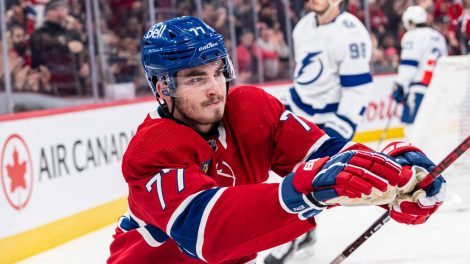After going through the best goal scorers, playmakers, and puck movers available at Monday’s NHL trade deadline, we’re continuing to focus on players who can fill specific needs for teams instead of just going for the best player available.
While the supply of puck-moving defencemen is a little bit thin this season, there are some quality options out there for defensive defencemen. To be clear, the most effective defencemen in the NHL are always proficient at more than one area of the game, meaning you can’t only be good without the puck and then a liability with it, however a one-dimensional defensive defenceman can help out on a third pairing if they’re insulated by a decent puck mover, for example.
To start with breaking down the best defensive defencemen available, let’s look at their on-ice defensive impact compared to when they’re not on the ice. If a player has a positive impact, the amount they reduce on-ice events against will be displayed as a positive number.

Brett Pesce has had among the best impact on shot quality of any player in the NHL this season. He’s one of only six defencemen with a high-danger scoring chance differential above 60 per cent at 5-vs-5, with only he and Ryan McDonagh playing top-four minutes.
Pesce is an incredible defensive defenceman who also made our list of puck movers, so you know that aside from stopping plays from happening in the defensive zone, he can skate the puck out of danger and start the transition as well.
Ben Lovejoy is a great example of a one-dimensional defenceman. He has enjoyed a long career as a depth blue-liner, finding a place as a regular on multiple teams over the years. He’s not going to contribute much offensively, and he’s going to struggle to move the puck, but even at 35 years old he consistently has a strong impact on shot quality in his own zone. Pair him with a good puck mover to form a solid third pairing, or if you’re a team that ices a sacrificial minute-eating unit whose job is to simply not get scored on, he’s a decent option there as well.
[relatedlinks]
Radko Gudas has a nearly equally strong impact at reducing high-danger chances and passes to the slot, which is a testament to his smart use of his physicality. A lot of defencemen who hit as hard and as often as Gudas does choose their timing poorly and their team suffers the consequences of their bad decision making and poor positioning. That’s a rarity for Gudas.
If your team is allowing too many passes to the slot, go after Nick Jensen. The 28-year-old is a fixture on these lists right now, and if the Red Wings move him, they should bring in a pretty nice return. His impact on high-danger chances hasn’t been as big, but the Red Wings don’t allow much pre-shot movement when he’s on the ice, and he’s one of the best puck movers available as well.
Alex Edler might be staying in Vancouver — that’s absolutely what he wants to do — but if things don’t work out he’s a good player to look at if you need to protect the front of the net. He doesn’t have the reputation of a great defensive player, his impact on shot locations in his own end is excellent, and he can contribute on a power play as well.
Chis Tanev is one of the best defensive defencemen in the league, so it’s no surprise he makes the list here. He also ranked as the top available transition defencemen, so if he’s traded the Canucks should be expecting a gigantic return.
While on-ice impact can give us a general idea of what’s accomplished while a player is on the ice, we can also examine how they’re achieving those on-ice numbers — what individual plays they’re making.

Looking at how each player exerts their impact defensively, you can see that Lovejoy and Jensen like to be more aggressive blocking passes in the neutral zone, while Edler and Gudas are a bit less willing to put themselves in lanes in the neutral zone, being a bit more conservative in their positioning.
Edler gets in the way of opposing puck movement in the defensive zone a lot, not just cutting off passes, but blocking more shots than anyone else. Edler’s weakness relative to the others on this list is winning puck battles; he’s slightly behind the field.
Tanev is the player that keeps standing out for me as the most impressive. If you had to sum him up in one sentence it would be: He gets in the way, gets the puck, and moves it up the ice.
You can see why Lovejoy has a strong impact defensively, he’s very aggressive without the puck both in the defensive and neutral zone, and only Tanev is better with stick checks. I still wouldn’t trust him in a top-four role, but I get why teams value him as a depth player.







